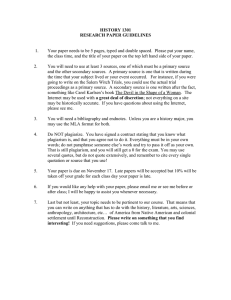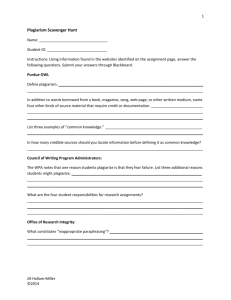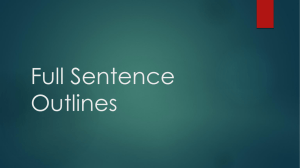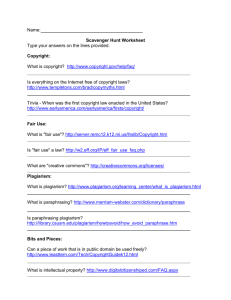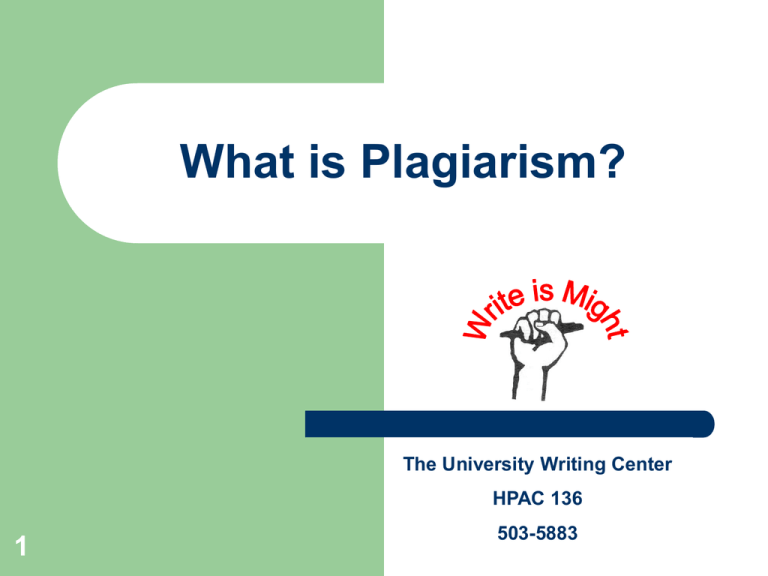
What is Plagiarism?
The University Writing Center
HPAC 136
1
503-5883
Plagiarism is a Form of
Intellectual Property Theft
What is Intellectual Property?
–
–
–
–
–
–
–
–
–
These are protected legally by:
–
–
–
2
An Idea
An Invention
An Expression or a Literary Creation
A Unique Name
A Business Method
An Industrial Process
A Chemical Formula
A Computer Program
A Presentation (“Intellectual Properties” )
Copyright
Patent
Trademark (Walker)
Plagiarism
3
Plagiarism is an older concept than that of
intellectual property. The word was first used by the
poet Martial “regarding someone who had
‘kidnapped’ some of his poems by copying them
whole and circulating them under the copier’s name”
(Morgan and Reynolds). One scholar may borrow
and build on the work of another, but he or she does
not outright steal it. Avoiding plagiarism is part of the
academic code of honor – and a part of an ages-old
tradition. Each student accepts responsibility for his
or her work upon entering the academy.
USC Upstate
Code of Academic Integrity
4
“Students are required to properly acknowledge sources as
follows: students may not present as their own ideas,
opinions, images, figures, languages or concepts of another,
including those of other students. Students must
acknowledge all sources such as magazines, journals,
Internet sites, records, tapes, films and interviews. The
common specific uses of source material are: direct
quotation; paraphrase; use of ideas; use of figures. . . . Any
of the following . . .may be cause for disciplinary action . . . .
Plagiarism, or literary theft, in any writing assignment: using
others’ words or ideas without consistent, correctly formatted
acknowledgement.” (“The Code of Academic Integrity” 9697).
General Examples of Plagiarism
5
Downloading a paper from an internet “paper mill.”
Handing in someone else’s paper and calling it your
own.
Copying and pasting large portions of internet
material without acknowledging the source.
Including source material without acknowledging the
source or indicating the location of the material
within the source.
Over-quoting, which results in a cumulative loss of
the writer’s voice.
Why Students Plagiarize
(adapted from University of Alberta Libraries)
1.
2.
3.
4.
5.
6
Lack of research skills
Poor paraphrasing skills
Careless note-taking
Confusion about how to properly cite
sources
Misconceptions about what plagiarism is
Why Students Plagiarize (cont.)
6.
7.
8.
9.
10.
7
Perception of online information as public
knowledge
Pressure from family, competition for scholarships
and jobs
Students ethics
Poor time management and organizational skills
Culturally-based attitudes towards plagiarism (“Why
Students Plagiarize”)
Key Documentation Conventions
8
Paraphrase properly.
Use quotation marks around direct phrases
or passages.
Acknowledge both paraphrases and direct
quotes in text and in bibliography.
Use ellipses to leave material out.
Use brackets to add material in.
Use long quotations sparingly.
Proper Paraphrasing
9
Original Source
Paraphrase – Well or Poorly
Written?
“Deep learning –
transformational learning –
requires struggle and periods of
getting worse before getting
better. The transformational
learning curve involves an
initial dip into ‘the pit.’ This is
the period of confusion and
frustration that is central to
most learning. Unfortunately
many designers of learning try
to design this period out of the
process (Costa 26).”
Deep understanding –
transformational learning –
demands grappling and spells
of sliding back before going
forward. The transformational
learning curve includes a first
dive into ‘the pit.’ This is the
time of turmoil and puzzlement
that is what most learning is
about. Unluckily, many
planners of learning try to plan
this time out of the operation.
Paraphrasing (con’t.)
Original Source
“Deep learning –
transformational learning –
requires struggle and periods of
getting worse before getting
better. The transformational
learning curve involves an
initial dip into ‘the pit.’ This is
the period of confusion and
frustration that is central to
most learning. Unfortunately
many designers of learning try
to design this period out of the
process (Costa 26).”
10
Assess This Paraphrase:
When trying to truly understand
a concept, Costa believes that
learners often experience a
period of “frustration and
confusion” at the outset of the
process. Instructors and other
“designers of learning” need to
take this into account (26).
Idea
is in writer’s own style but is
attributed to original author.
Key words and phrases are in “ “.
Source page is cited (req. for MLA).
General Citation Issues
Original Text
“Freewriting is a kind of structured
11
brainstorming, a method of
exploring a topic by writing about it
– or whatever else it brings to mind –
for a certain number of minutes
without stopping. It consists of a
series of exercises, conducted either
in class or at home, during which
students start with a blank piece of
paper, think about their topic, and
then simply let their minds wander
while they write. For as long as their
time limit, they write down
everything that occurs to them (in
complete sentences as much as
possible). They must not stop for
anything”
(Glenn, Goldthwaite & Connors 225).
Plagiarized or Not?
According to Glenn, Goldthwaite and
Connors, freewriting is a kind of
structured brainstorming, a method of
exploring a topic by writing about it (225).
Freewriting is made up of a succession of
drills, carried out either in school or out,
when learners begin with an empty
journal page, ruminate about their subject
matter, and then allow their brains to
meander while they jot down ideas (Glenn
et al. 225).
Glenn, Goldthwaite and Connors define
“freewriting” as a period of time when
writers are encouraged to let ideas flow
freely onto their pages without
interruption for a prescribed period of
time (225).
Example of Over-quoting
12
Better
13
Guidelines for Avoiding Plagiarism
1.
2.
3.
4.
14
Maintain consistent note-taking practices - keep
track of whether your notes are paraphrases or
direct quotes.
Include page numbers of cited material in your
notes.
Give full credit to any source material you use,
whether paraphrased or quoted directly.
Be sure to use acknowledgment phrases, in-text
citations and a work cited or bibliography page.
(Veit and Gould 399)
Guidelines (cont.)
15
5.
Know the citing conventions of the
documentation style you are using.
6.
Maintain your own voice and style by
paraphrasing – do not over-quote.
7.
When in doubt, CITE!
Where to Get Help
16
University Writing Center (HPAC 136)
Upstate Library Reference Desk
Your instructor
Writing and Usage manuals
Upstate! Student Handbook
Works Cited
Costa, Arthur, ed. Developing Minds: A Resource Book, for Teaching Thinking. Alexandria:
ASCD, 2001. 26.
Glenn, Cheryl, Melissa Goldthwaite and Robert Connors. The St. Martin’s Guide to Teaching
Writing. 5th ed. Boston: Bedford/St. Martin’s, 2003.
“Intellectual Properties.” The University of Texas at Arlington. 26 Jan. 2004.
<http://www.uta.edu/tto.ip-defs.htm>.
Morgan, Peter and Glenn Reynolds. “A Plague of Originality.” In The Appearance of
Impropriety: How the Ethics Wars Have Undermined American Government, Business and
Society. Free Press, 1997.
“The Code of Academic Integrity.” Upstate! Student Handbook: 2005-2006.
Veit, Richard and Christopher Gould. Writing, Reading and Research. New York:
Pearson/Longman, 2004.
Walker, J. “Intellectual Property in the Information Age: A Classroom Guide to Copyright.”
University of South Florida. 1997. 26 Jan. 2004.
<http://www.cas.usf,edu/english/walker/papers/copyright/ipdummie.html>.
“Why Students Plagiarize.” The University of Alberta Libraries. 2002. 26 January 2004.
<http://www.library.ualberta.ca/guides/plagiarism/why/index.cfm>.
17

